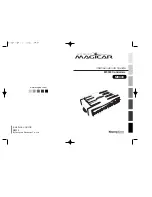
Document NO.: RD-529-39-001
Version: A
- 2 -
a potential danger. However, there may be some
circumstances where a household member may not hear the
alarm (i.e. outdoor or indoor noise, sound sleepers, drug or
alcohol usage, the hard of hearing, etc.). If you suspect that
this smoke alarm may not alert a household member, install
and maintain specialty smoke alarms. Household member
must hear the alarm’s warning sound and quickly respond
to it to reduce the risk of injury, or death that may result
from fire, if a household member is hard of hearing, install
special smoke alarms with lights or vibrating devices to
alert occupants.
7:Smoke alarms can only sound their alarms when they
detect smoke or detect combustion particles in the air. They
do not sense flame or gas. This smoke alarm is designed to
give audible warning of a developing fire. However, many
fires are fast - burning, explosive, or intentional, and others
are caused by carelessness or safety hazards. In such
circumstances, Smoke may not reach the alarm
QUICKLY
ENOUGH
to ensure safe escape. Therefore the installation
of smoke alarms is not a substitute for practicing fire safety
in the home.
8:Smoke alarms have limitations. This smoke alarm is not
foolproof and is not warranted to protect lives or property
from fire. Smoke alarms are not a substitute for insurance.
Homeowners and renters should have adequate insure to
protect their lives and property. In addition, it is possible for
the smoke alarm to fail at any time. For this reason, you
must test the smoke alarm weekly and replace them every 5
years.
Do Not Install Smoke Alarms in
the Following Places:
1: Near appliances or areas where normal combustion
Regularly occurs (kitchens, near furnaces, hot water
heaters). Use specialized smoke alarm device with
unwanted alarm control for this areas.
2: In areas with high humidity, like bathrooms or areas near
dishwashers or washing machines. Install al least 10feet
away from these areas.
3: Near air returns or heating and cooling supply vents.
Install at least 3 feet away from these areas. The air could
blow smoke away from the detector, interrupting its
alarm.
4: In rooms where temperatures may fall below 0
℃
or rise
above 40
℃
,
or in humidity higher than 93%. These
conditions will reduce battery life or cause a fault alarm.
5: In extremely dusty, dirty, or insect – infested areas
influence particles interfere with smoke alarm device
operation.
Battery Specification:
Rating voltage: DC 3V
Package:
lithium battery
Recommend battery:
EVE : CR17450
Replace Battery:
1:Turn the alarm body counterclockwise and take out the
alarm body from the bracket.
2:Take out the old battery from the battery box.
3:Fix the new batteries to the battery box. Please note the
battery polarity. Reverse can lead to battery life
4: Fit alarm body on bracket and turn the alarm body
clockwise.
5: Test smoke alarm using test button. The sound pattern is 3
short and weak beeps, 1.5seconds pause, 3 short and week
beeps, 4.5seconds pause, repeat it, If continue testing , the
beeps will become louder. If there’s no sound output, it
means that the smoke alarm is faulty or the installing
operation is wrong, and you should gain the correctly
method of disposal through reading “TROUBLE
SHOOTING”.
NOTE:
During testing, because the unit send the wireless
signal, the other smoke detector will alarm. Once release
the test button, the other smoke detector will stop alarming
in one minute.
Operation:
Testing
Test the unit weekly to ensure proper operation by pressing
the test button. This will sound the alarm if the electronic
circuitry, horn, and battery are working properly. If no alarm
sounds, the battery may be depleted or another problem, refer
to “Trouble shooting” section for a solution.
DO NOT
use an open flame to test your alarm, you could
damage the alarm or ignite combustible materials and start a
structure fire.
CAUTION:
Always stand an arms-length away from the unit
when testing. Test the alarm weekly to ensure proper
operation. Erratic or low sound coming from your alarm may
indicate a defective alarm. Refer to “Trouble shooting”
section for a solution.

























